| History of Korea |
|---|
 |
| Timeline |
|
|
This is a timeline of Korean history.
Early history
- 2333 BC: Legendary establishment of Gojoseon by Dangun.[1]
- 1500 BC: Beginning of the Mumun pottery period.[2][3][4]
- 700 BC: Beginning of the Liaoning bronze dagger culture.[5]
- 323 BC: Estimated beginning of the Gojoseon-Yan War that eventually ends in Gojoseon's loss of the Liaodong penninsula to Yan.[6]
- 300 BC: Beginning of the Iron Age.[7]
- 300 BC: Establishment of Jin in southern Korean peninsula.[8]
Proto-Three Kingdoms
- 195 BC: Establishment of Wiman Joseon.[9]
- 108 BC: Han dynasty destroys Wiman Joseon, establishing four commanderies in northern Korean Peninsula.[10]
- 100 BC: Buyeo, which Goguryeo and Baekje claim descent from, is established sometime around the 1st century BC.
- 57 BC: Traditional date for the founding of Silla by Bak Hyeokgeose, who is elected leader.[11]
- 37 BC: Traditional date for the founding of Goguryeo by Jumong, a Prince of Buyeo.[12]
- 18 BC: Traditional date for the founding of Baekje by Onjo, a Buyeo Nobleman or the third son of Jumong according to different sources.[13][14]
Three Kingdoms
- 42: Traditional date for the founding of Gaya by Suro.[15]
- 53: Goguryeo begins to become a centralized kingdom under Taejo's reign.[16]
- 234: Baekje begins to become a centralized kingdom under Goi's reign.[17]
- 244: Goguryeo is defeated by Cao Wei in the Goguryeo–Wei War, the defeat is so severe that Goguryeo is not mentioned again in Chinese historial record for decades.[18]
- 313: Goguryeo destroys Lelang Commandery, ending the last of the four Han Chinese commanderies established by the Han Dynasty.[19]
- 356: Silla becomes a centralized kingdom under Naemul's reign.
- 371: Baekje's King Geunchogo invades Goguryeo and kills King Gogugwon.[20]
- 372: Under Sosurim, Goguryeo imports Buddhism from Former Qin of China and adopts it as state sponsored religion.[21]
- 372: Sosurim also establishes Korea's first National Confucian Academy.[22]
- 384: Chimnyu of Baekje officially adopts Buddhism.[23]
- 392: Gwanggaeto the Great of Goguryeo begins his reign, expanding Goguryeo into a major regional power.[24]
- 413: Jangsu of Goguryeo erects the Gwanggaeto Stele.[25]
- 433: Baekje and Silla form an alliance against Goguryeo's aggression.[26]
- 475: Goguryeo attacks Baekje and captures Hanseong (modern day Seoul).[27] Baekje moves its capital south to Ungjin (modern-day Gongju) due to Goguryeo's pressure.
- 494: Last remains of Buyeo absorbed by Goguryeo.[28]
- 498: Baekje attacks Tamna (modern-day Jeju Province), which enters into a tributary relationship with Baekje as a result.
- 512: Silla vassalizes Usan (modern-day Ulleungdo).[29]
- 520: Silla formalizes the Bone-rank system, an aristocratic rank system that acted as a caste system under the reign of Beopheung of Silla.
- 527: Silla formally adopts Buddhism after Beopheung of Silla executes Ichadon, a Buddhist convert who had tried to persuade the king to adopt Buddhism.[30] Before he was executed, Ichadon predicted that milk colored blood would spill from his body after his death.[31] This supposed miracle allegedly occurred according to the Samguk Sagi and convinced Silla's royal court to adopt Buddhism as its state religion.
- 538: Baekje moves its capital to Sabi (modern-day Buyeo).[32]
- 553: Silla attacks Baekje, breaking the alliance.[33]
- 562: Silla completes annexation of Gaya.[34]
- 598: First of a series of major Sui dynasty attacks in the Goguryeo–Sui War, which ends in 614 in a costly defeat for Sui.[35]
- 612: Goguryeo repulses second Sui invasion at the Salsu.
- 631: Goguryeo builds the first Cheolli Jangseong following Tang incursions into Goguryeo's northwestern border.
- 645: First campaign in the Goguryeo–Tang War.
- 648: Silla establishes alliance with Tang.
- 660: Baekje falls to the Silla-Tang forces.
- 662: As a result of the fall of Baekje, Tamna enters into a tributary relationship with Silla.
- 663: Battle of Baekgang, the remnants of Baekje allied with Japanese expeditionary forces are defeated by the Silla-Tang alliance, ending all hopes for the restoration of the kingdom.
- 668: Goguryeo falls to the Silla-Tang forces.
North–South States Period and Later Three Kingdoms
- 676: Silla repels Chinese alliance forces from Korean peninsula, completes unification of much of the Three Kingdoms.
- 698: The founding of Balhae by former Goguryeo general Dae Joyeong.
- 751: Silla, at its cultural peak, constructs Seokguram and Bulguksa.
- 828: Jang Bogo establishes Cheonghaejin, a major center of trade with China, Japan, and Vietnam.
- 892: Silla begins to lose control of parts of the peninsula as the brief Later Three Kingdoms period begins.
- 897: Queen Jinseong of Silla dies. She was the third and last queen regnant in Korean history.
- 900: Hubaekje ("Later Baekje") established in the southwest of the peninsula.
- 901: Taebong ("Later Goguryeo") established in the northwest of the peninsula.
- 918: Founding of Goryeo by Taejo of Goryeo.
- 926: Balhae falls to Khitan forces.
- 935: Silla formally surrenders to Goryeo.
- 936: Hubaekje formally surrenders to Goryeo.
Goryeo
- 936: Goryeo completes the reunification of the Later Three Kingdoms, absorbing the entirety of Hubaekje and parts of former Balhae territory.
- 938: Goryeo subjugates Tamna
- 956: Emperor Gwangjong forces major land and slavery reforms, and in 958 implements civil service examinations.
- 979: According to the Goryeosa, tens of thousands of Balhae refugees from Jeongan fled to Goryeo in 979, and was recorded as the largest Balhae migration since the 936 exodus.[36]
- 986: Jeongan falls to the Liao Dynasty.
- 993: The first of three Goryeo–Khitan Wars.
- 1010: The second ravages the northern border.
- 1018: The third, Khitan successfully repelled.
- 1033: Goryeo builds the second Cheolli Jangseong (lit. "Thousand Li Wall"), also known as the Goryeo Jangseong, a massive wall running along the northern border.
- 1135: Buddhist monk and geomancer Myocheong rebels in a failed attempt to move the capital to Pyongyang and pursue aggressive expansion against the Jin Dynasty
- 1145: Kim Bu-sik compiles the Samguk Sagi, Korea's oldest extant history text.
- 1170: Yi Ui-bang overthrows Uijong of Goryeo, beginning a century of military rule known as the Goryeo military regime
- 1231: The Mongol invasions of Korea begin
- 1234: Choi Yun-ui's Sangjeong Gogeum Yemun is published, world's first metal-block printed text.
- 1251: Goryeo completes the Tripitaka Koreana, the most comprehensive and oldest intact version of the Buddhist canon in Chinese script
- 1268: Mongol peace treaty is signed which Mongols agree to protect them the best they can.
- 1270: Goryeo signs a peace treaty with the Mongols, beginning an 80-year period of Yuan overlordship. The Sambyeolcho Rebellion lasts for three more years.
- 1274: Goryeo helps the Mongol Empire during the Mongol invasions of Japan
- 1285: Il-yeon compiles the Samguk Yusa, record of history and legends
- 1356: Goryeo regains its independence under the reign of King Gongmin of Goryeo and momentarily conquers Liaoyang
- 1388: General Yi Seonggye, ordered to engage China in a border dispute, turns his troops against the Goryeo court.
Joseon
- 1392: Yi Seonggye is crowned King Taejo, officially beginning the Joseon dynasty.
- 1394: Capital moved to Hanyang (modern-day Seoul)
- 1402: Paper currency initiated
- 1408: High military service examination system created
- 1412–1414: Namdaemun Market, the oldest extant market in Korea, is established.[37]
- 1420: Hall of Worthies established
- 1424: History of Goryeo compiled
- 1446: The Hangul alphabet, created 3 years earlier, is promulgated by King Sejong the Great.
- 1592: The Japanese invasion of Korea begins under the command of Toyotomi Hideyoshi. Admiral Yi Sun-sin employs the Turtle ship to repel Japanese naval forces.
- 1627: The Later Jin invasion of Joseon
- 1636: The Qing invasion of Joseon ends in Joseon's defeat, and Korea is made a tributary of the Qing Dynasty.
- 1653: Dutch mariner Hendrick Hamel crashes on Jeju Island. The isolationist Joseon government prevents him from leaving, although he is given relative freedom to live normally on the peninsula.[38][39]
- 1666: Hamel and some of his crew sneak from the southern coast of Korea to Dejima, Japan. From there, they make their way back to the Netherlands. Hamel then publishes a written account of his travels in Korea: the first first-hand eyewitness description of Korea by a Westerner.[38][39]
- 1762: Crown Prince Sado is ordered to committ suicide by his father Yeongjo of Joseon in one of the most popularized incidents in Korean history.
- 1791: Persecution of Catholicism begins.
- 1864: Gojong ascends the throne with his father, Daewongun, as Regent.
- 1866: French Campaign against Korea.
- 1871: United States expedition to Korea.
- 1876: Korean ports are formally opened under the Treaty of Ganghwa with Imperial Japan.
- 1881: 10 December. Chōsen shinpō, primarily a Japanese-language and Classical Chinese publication, became the first newspaper to be published in Korea.[40]
- 1882: Imo Incident: Mutiny by Korean soldiers in Seoul against the modernization policies of emperor Gojong
- 1883: The first Korean diplomatic mission to the United States also gives rise to the first Koreans to set foot in North America, the first Korean to study abroad in the United States (Yu Kil-chun), and the first Korean to circumnavigate the globe (Min Yong Ik). In the following decades, hundreds of Korean students visit the United States to study.
- 1883: October. The first modern Korean-language newspaper, Hanseong sunbo, is established by the Joseon monarchy.[41]
- 1884: Kim Ok-gyun leads the Gapsin Coup. In 3 days, Chinese forces are able to overwhelm the Progressives and their Japanese supporters.
- 1885: October 11. The first Methodist church in Korea, Chungdong First Methodist Church is established in Seoul by American missionary Henry Appenzeller. The church's main chapel, built in 1897, is now the oldest extant church in Korea, and the only one built in the 19th century.[42]
- 1894: The beginning of the Donghak Peasant Rebellion prompts the Gabo Reforms in an attempt to prevent Korea's colonization, and China and Japan fight over sovereignty of Korea in the First Sino-Japanese War.
- 1895: After Japanese victory in the Sino–Japanese War, China recognizes Korean independence in the Treaty of Shimonoseki.[43]
- 1895: Empress Myeongseong is assassinated by Japanese agents.
- 1895: Ae Kwan Theater, the first movie theater in Korea, is established in Incheon.[44]
- 1896: 11 February. Gojong's internal exile to the Russian legation.
Korean Empire
- 1897: 20 February. King Gojong returns to his palace after 1 year of refuge at the Russian legation.
- 1897: King Gojong proclaims the Korean Empire and is crowned at the religious shrine Hwangudan in Seoul.[45]
- 1902: The first modern indoor theater in Korea, Hyŏpyul-sa, is established in Seoul.[46]
- 1903: The first Korean immigrants to the United States arrive in Hawaii.
- 1905: Treaty of Portsmouth ends the Russo-Japanese War in Russian defeat and leads to uncontested Japanese dominance of Korean politics
- 1905: Japan–Korea Treaty of 1905. Korea became a protectorate of the Empire of Japan.[43]
- 1907: Historic movie theater Dansungsa is founded in Seoul.[47]
- 1907: June. The Hague Secret Emissary Affair occurs, in which emissaries from Gojong attempt to assert Korea's independence in Europe, but are rebuffed.
- 1907: 18 July. Gojong is forced to abdicate in favor of his son, Sunjong by Imperial Japan.
- 1908: 25 March. Durham Stevens, an American diplomat and Japanese sympathizer, is assassinated by Korean independence activists.
- 1909: 26 October. The Japanese Resident-General of Korea Itō Hirobumi is assassinated by Korean independence activist An Jung-geun
- 1910: 29 August. The Japan–Korea Treaty of 1910 started the annexation of the Korean Empire by Imperial Japan.
Japanese colonial rule
- 1911: The 105-Man Incident occurs, in which the Japanese arrest over 700 Koreans in connection to alleged assassination attempts on the Governor-General of Korea, Terauchi Masatake.
- 1916: The final wave of Uibyeong rebels is defeated by Japanese forces.
- 1919: 21 January. Gojong suddenly dies, widely believed to have been poisoned.
- 1919: 8 February. Inspired by the promotion of self-determination laid out in the Fourteen Points statement, Korean independence activists in Japan publish a February 8 Declaration of Independence. This directly inspires a similar act in Korea three weeks later.[48]
- 1919: March 1st Movement and the publication of the Korean Declaration of Independence. Nationwide non-violent demonstrations are crushed by Japanese military and police forces after two months. Governor-General Hasegawa resigns.
- 1919: 11 April. The Korean Provisional Government (KPG) is established in exile in Shanghai, and Syngman Rhee is elected its first leader.
- 1919: September. Saito Makoto appointed as third Governor-General of Korea. The period of "cultural policy" begins.
- 1919: October 27. The kino-drama, Righteous Revenge, widely considered the first Korean film, premieres at Dansungsa. This marks the anniversary of the modern Korean Film Day, although whether it is truly the first Korean film has been disputed.[49][50][51]
- 1920: Kim Il Sung (then "Kim Song-ju") and his family flee to Manchuria.[52]
- 1920: Battle of Qingshanli between the Imperial Japanese Army and the Korean Independence Army led by Kim Chwa-chin, both sides claim victory.
- 1923: The Koryo-saram newspaper Sŏnbong is established. It changed names to the Lenin Kichi in 1938 and Koryo Ilbo in 1991. As of 2023, it is the oldest active Korean-language newspaper outside of the Korean peninsula.[53]
- 1923: 1 September. In the immediate aftermath of the Great Kantō earthquake in Japan, the Kantō Massacre occurs. Rumors emerge that ethnic Koreans had poisoned wells or were planning to attack the Japanese.[54] The Japanese military, police, and bands of armed vigilantes massacre thousands of Koreans, anyone they suspect of being Korean, and Japanese anarchists or left-wingers.[55][56] The Japanese government then begins a campaign to minimize or downplay the scale of the massacre.[57][58]
- 1926: The June 10th Movement pro-independence protests occur and are suppressed.
- 1931: The Korean Patriotic Organization (KPO) is founded.
- 1932: 9 January. The Sakuradamon incident occurs, in which KPO member Lee Bong-chang fails in his attempt to assassinate Emperor Hirohito in Tokyo.
- 1932: 29 April. The Hongkou Park Incident occurs, in which Yun Bong-gil sets off a bomb in a park in Shanghai (now Lu Xun Park), killing several Japanese colonial and military leadership. In the aftermath, the KPG is forced to flee Shanghai.[59][60]
- 1932: Japan begins the "comfort women" program, in which civilian women were coerced or forced into prostitution for the Japanese military. By the end of World War II, an estimated 100,000–200,000 Korean women would be forced into sexual slavery by Imperial Japan.
- 1934: The Chinese Kuomintang assists in training 92 Korean guerrilla fighters in the 17th Army Officer Training Class of the 4th Battalion (제2총대 제4대대 육군군관훈련반 제17대) in Luoyang.
- 1937: 4 June. Kim Il Sung leads 150–200 guerrillas in the Battle of Pochonbo.[52]
- 1937: September. The deportation of Koreans in the Soviet Union occurs, in which roughly 172,000 Koreans are forced to move from the Russian Far East to Central Asia. Conditions during the journey and at their destination are poor, and death toll ranges from 16,500 to 50,000.
- 1937: November/December. The KPG flees Nanjing just weeks before the Nanjing Massacre.
- 1938: 1 March. Samsung is established in Daegu.
- 1938: Governor-General of Korea begins Sōshi-kaimei (Order to Japanese-style name changes) policy.
- 1939: 24 March. The State General Mobilization Law is passed, and millions of Koreans are forcefully conscripted to work for Japan. Tens of thousands die due to poor work conditions.
- 1939: The KPG settles in Chongqing, where they would remain until the end of the war.
- 1940: 17 September. The KPG establishes the Korean Liberation Army, a guerrilla army that was intended to eventually fight to liberate the Korean peninsula. At its peak, it reached over 400 personnel.
- 1940: Kim Il Sung and a few survivors escape from China into the USSR.[52]
- 1943: 27 November. The Cairo Declaration between China, the United States, and the United Kingdom announces the intention of the Allies to liberate Korea after World War II, but place it under a trusteeship. This both excites and angers Koreans.[61][43]
- 1944: Starting in 1944, Japan started the conscription of Koreans into the armed forces. All Korean males were drafted to either join the Imperial Japanese Army, as of April 1944, or work in the military industrial sector, as of September 1944.
- 1945: 8 February. At the Yalta Conference, Roosevelt secretly proposes to Joseph Stalin that Korea be placed a three-way trusteeship, between China, the USSR, and the US for a period of 20–30 years, and that no troops be stationed on the peninsula. Stalin mostly agrees, but argues that the trusteeship should be as short as possible.[61][62][63]
- 1945: May. The Eagle Project, a joint operation between the KPG and the United States Office of Strategic Services, occurs. Kim Gu and others are hopeful that it will facilitate the US's formal recognition of the KPG, but Truman rebuffs Kim's attempts at communication and the mission is halted after the atomic bombings of Japan.[64][65]
- 1945: July. It is decided during the Potsdam Conference and announced via the Potsdam Declaration that the Cairo Declaration's terms on Korea would be affirmed.[61]
- 1945: 11 August. The General Order No. 1, drafted by the United States, specified the division of Korea at the 38th parallel. Stalin did not object to the terms.[61]
- 1945: 11 August. Soviet troops begin their first military operation in Korea, and land in Unggi County (later renamed Sonbong-guyok).
- 1945: 13–17 August. The Seishin Operation is fought between the Soviet Union and Japan. Despite being outnumbered, the Soviet troops win. Chong Sang-chin is the only ethnic Korean to fight on the Soviet side.
- 1945: 15 August. Japan surrenders to the Allies, marking the liberation of Korea.
Division of Korea
- 1945: 15 August. The Korean peninsula is haphazardly divided along the 38th parallel into the Soviet Civil Administration (SCA) in the North and the United States Army Military Government in Korea (USAMGIK) in the South.[66]
- 1945: 3 September. The head of the Pyongyang branch of the Communist Party of Korea, Hyŏn Chun-hyŏk, is assassinated, likely by the right-wing terrorist group Daedongdan.[67]
- 1945: 6 September. Before both trusteeships are well-established, Lyuh Woon-hyung establishes an independent People's Republic of Korea that incorporates both left- and right-leaning politicians. However, its activities are quickly suppressed and it never gains recognition from either the USSR or US.[68]
- 1945: 19 September. Kim Il Sung returns to the Korean peninsula with the Soviets.[69]
- 1945: December. At the Moscow Conference, negotiations to reunify Korea fail. Instead, Korea is placed under a four-way trusteeship, by the Soviet Union, the United States, the United Kingdom, and China for five years. This leads to protest and anger in the Korean peninsula.[43]
- 1946: 4 January. Cho Man-sik, Kim's main rival for leadership in the North, is removed from office and placed under house arrest by the Soviets.[70]
- 1946: 8 February. The Provisional People's Committee of North Korea is established, and Kim Il Sung is made its chairman. While it supposedly represents all political groups in the North, it is dominated by the Soviet-backed Communist Party.[71]
- 1946: 1 July. North Korea creates its first film: Our Construction.[72][73]
- 1946: December. A coalition is made in the North among all major political parties, including representatives of left-leaning parties in the South. This coalition is again dominated by the Communists.[74]
- 1947: Hyundai is established, initially as a construction company.
- 1947: 19 July. Lyuh Woon-hyung, whom some Americans had been eyeing as a more moderate alternative candidate for leadership in the South,[75] is assassinated by a member of the far-right terrorist group the White Shirts Society.[76]
- 1947: 14 November. The United Nations passes General Assembly Resolution 112, which creates the United Nations Temporary Commission on Korea. The commission was intended to monitor the integrity of elections throughout the peninsula.[77] This resolution was the result of a September initiative by the United States, which was frustrated by the lack of Soviet cooperation in negotiations about the administration of Korea. The Soviets dispute the authority of the Commission and ignore it.[78]
- 1948: April. Protests occur in Jeju that lead to the Jeju Uprising. The protests began in response to the news of separate elections occurring in North and South Korea. These are violently suppressed by 1949.[79][78] The estimated death toll is uncertain, but a significant portion (up to 30%) of the population is killed.[80] This event and its aftermath significantly threaten the Jeju language,[81] which as of 2023, is considered critically endangered.[82]
- 1948: 10 May. Despite significant controversy, elections for the National Assembly are held in South Korea, and Syngman Rhee becomes its chair.[78]
- 1948: 15 August. Establishment of the Republic of Korea with Syngman Rhee as President.[83]
- 1948: 9 September. Establishment of the Democratic People's Republic of Korea with Kim Il Sung as Premier.[83]
- 1948: October. The Yeosu–Suncheon rebellion occurs. While being shipped off to Jeju to suppress the unrest, left-leaning soldiers launch a rebellion in South Jeolla Province. Thousands are killed.[80]
- 1948: 20 November. The South Korean National Assembly passes the National Security Law. The law has been consistently criticized for its broad scope and historical use by South Korean dictatorships to quash political resistance.[80]
- 1949: 26 June. Kim Ku is murdered in his home by Ahn Doo-hee. The exact motives behind the murder still remain unclear.[84]
- 1950: 30 January.[85] After months of negotiations, Stalin finally relents to Kim's requests to launch an invasion of the South, but makes it conditional on whether Kim can convince Mao to support the effort.[86][87]
- 1950: April. Mao agrees to support Kim in the invasion.[86][87]
Korean War

Animated map of the Korean War
- 1950: 25 June. The Korean War begins with a surprise attack from the North. While minor border skirmishes had happened prior to the war, they are not comparable in scale of the invasion the North launches. The First Battle of Seoul begins with the deaths of hundreds of civilians; Seoul falls within a few days.[88]
- 1950: 7 July. The UN Security Council creates the United Nations Command under the United States to support the South. Over the following years, tens of thousands of soldiers from a number of countries fight for the South.[89]
- 1950: 26 to 29 July. The No Gun Ri massacre occurs. Unarmed South Korean civilians near the village of Nogeun-ri are deliberately killed by the US Army; the death toll and cause of the massacre is disputed.[90]
- 1950: August. UN forces are driven back to the south-east corner of the Korean Peninsula ("The Pusan Perimeter").[91]
- 1950: September. The Battle of Inchon occurs after UN Troops make a surprise amphibious landing on the west coast. Despite the death toll, the UN resolution's original goal of returning to the status quo borders, and the concerns of the US's allies that China or the USSR could enter the war, MacArthur and Rhee decide to push North and reunify the peninsula. The UN approves this on 7 October, and troops move North on 9 October. This prompts the Chinese to begin planning a counteroffensive.[92]
- 1950: 19 October. Chinese forces as the People's Volunteer Army under Peng Dehuai secretly enter the North.[93]
- 1950: 27 November. Chinese forces launch a massive offensive from the North, which puts the UN and ROK forces into a full retreat.[91]
- 1950: 6 December. The Chinese retake Pyongyang.[93]
- 1950: December. The National Defense Corps incident begins and lasts until February 1951. The Rhee government drafts hundreds of thousands of civilians into a militia, but fail to provide them adequate supplies. Tens of thousands die or disappear.[93][94]
- 1951: 4 January. The North and China take Seoul.[93]
- 1951: 15 March. Seoul is retaken by the ROK and UN Forces.[93]
- 1951: July. Armistice talks begin. While the establishment of a demilitarized zone and the creation of an armistice commission are agreed on, the talks stall on the issue of prisoner exchanges. Over the following two years of more stalled talks, the US and UN Forces drop more bombs on North Korea than the Allies did on Germany and Japan in World War II. Both the North and the South commit atrocities against their own citizens and civilians on the other side. Over a million and up to two million Koreans die.[95]
- 1953: 27 July. The Korean War is halted by the Korean Armistice Agreement that has remained in force until now.
Modern period
- 1955: March 1955. Chongryon, an association for Koreans in Japan that are aligned with North Korea, is created. It has continued to draw controversy and criticism until today.
- 1956: April. Chongryon assists in establishing the North Korean-aligned Korea University in Tokyo.
- 1956: September. The August Faction Incident occurs, in which pro-Soviet and pro-Chinese North Koreans attempt to purge Kim Il Sung from power. Kim then conducts a counter-purge, which diplomatically distances North Korea from its Soviet allies.
- 1960: A student uprising begins the April Revolution which overthrows the autocratic First Republic of South Korea. Syngman Rhee resigns and goes into exile.
- 1961: 16 May. The May 16 coup occurs, in which General Park Chung Hee overthrows the Second Republic of Korea.
- 1961: 12 November. Summit conference for normalization of Korean-Japanese relations.
- 1962: January. Start of the first Five-Year Plan of South Korea.[96]
- 1962: 12 October. Sino–Korean Border Agreement is signed, beginning the process of establishing the modern border between China and North Korea. The process finishes with the agreement's 1964 companion, the Protocols on the Sino–Korean Border.
- 1964: South Korea joined Vietnam War.
- 1965: 22 June. The signing of Treaty on Basic Relations between Japan and the Republic of Korea. Earned both much controversy and procurement of budgets for later economic developments.
- 1966: The World Bank organizes the International Economic Consultative Organization for Korea
- 1967: start of the second Five-year plans of South Korea.
- 1968: January. The Blue House raid, an unsuccessful attempt of North Korean commandos to assassinate South Korean president Park Chung Hee occurs.
- 1968: April. In retaliation for the Blue House raid, a South Korean group is created (Unit 684) to assassinate Kim Il Sung, but the group eventually mutinies on 23 August.
- 1968: 1 April. Establishment of the Pohang Iron and Steel Company (now "POSCO").
- 1968: 5 December. Proclamation of the National Education Charter.
- 1970: 22 April. Start of the government-operated New Community Movement.
- 1970: Gyeongbu Expressway is completed and opened to traffic.
- 1972: start of the third Five-year plans of South Korea.
- 1972: 12 August. The first Red Cross talks between North and South Korea are held.
- 1972: President Park Chung Hee declares Emergency martial law and changes Constitution in August, which may allow him to become the permanent ruler. This is similar to Gojong of the Korean Empire stating his country's governmental system as 'autocratic' in the constitution- for greater leadership and less opposition.
- 1974: 15 August. The assassination of first lady Yuk Young-soo by North Korean sympathizer Mun Se-gwang.
- 1976: 18 August. The Axe Murder Incident in Panmunjom, Joint Security Area. Triggers former North Korean leader Kim Il Sung's first official apology to the South.
- 1976: 12 October. Discontinuation of rice imports, the accomplishment of total self-sufficiency in rice by the 'Unification Rice'.
- 1977: start of the fourth Five-Year Plans of South Korea.
- 1977: 22 December. Celebration of achievement of 10 billion dollars gained by exports.
- 1978: 26 October. Detection of the 3rd tunnel. Made by North Korea to attack South Korea.
- 1978: 10 December. Achievement of 1,117 US dollars as GNP.
- 1979: American president Jimmy Carter visits Korea. Threatens Park by stating he would reduce the US forces in Korea if he does not stop the ongoing Nuclear Weapons Development project.
- 1979: 26 October. President Park Chung Hee is assassinated by the chief of KCIA, Kim Jae-gyu (Assassination of Park Chung Hee).
- 1979: Coup d'état of December Twelfth, Chun Doo-hwan gets military power
- 1980: Gwangju Uprising. Martial law is declared throughout the nation. The city of Gwangju becomes a battleground between dissenters and the Armed Forces (18–27 May). The official death toll was set at 200 people but some reports claim over 1000 casualties.
- 1981: 16 November. A South Korean expedition team marks the first time Koreans set foot in Antarctica.[97][98]
- 1987: The June Democratic Struggle begins, which eventually overthrows the autocratic Fifth Republic of South Korea. The ruling party of Fifth Republic, Democratic Justice Party, then declares democratic elections.
- 1988: 24th Olympic Games are held in Seoul.
- 1990: 11 September. South Korea and the USSR established diplomatic relations.
- 1991: 17 September. North Korea (DPRK) and South Korea (ROK) join the United Nations (UN).
- 1991: 26 December. The end of the Cold War as the Soviet Union collapses and North Korea loses military and economic aid.
- 1992: 11 August. South Korea's first satellite, KITSAT-1, a.k.a. 우리별 (Uri Byol) is successfully launched from Guiana Space Centre.
- 1992: 24 August. South Korea and the People's Republic of China (PRC) establish diplomatic relations.
- 1993: Test of Rodong-1, a single-stage, mobile liquid propellant medium-range ballistic missile by the DPRK.
- 1994: Kim Jong-il takes control of North Korea upon the death of his father Kim Il Sung.
- 1994: Start of the North Korean famine.
- 1994: 21 October. The Seongsu Bridge disaster occurs in Seoul.[99]
- 1995: 29 June. The Sampoong Department Store collapses in Seoul.
- 1997: Asian Financial Crisis (or "IMF Crisis" as it was called in Korea) shakes Korea
- 1998: Taepodong-1, a two-stage intermediate-range ballistic missile is developed and tested by the DPRK. End of the Arduous March. It is possible that up to 3.5 million people did not survive the 'march'.
- 1998: The Shimonoseki Trial, the first ever lawsuit against the Japanese government by comfort women or forced laborers by Koreans, ends with the denial of compensation for the three women.[100][101]
- 1999: The DPRK promises to freeze long-range missile tests.
- 2002: The 2002 FIFA World Cup jointly held by Korea & Japan. South Korea national football team reaches the semi-finals for the first time in Korean football history. The DPRK pledges to extend moratorium on missile tests beyond 2003.
- 2004: The DPRK reaffirms moratorium.
- 2005: The DPRK fires short-range missile into the Sea of Japan (East Sea).
- 2006: Test of Taepodong-2 by DPRK, a successor of Taepodong-1.There is a nuclear test in the DPRK. US officials assert it might have been a misfire.
- 2007: The second summit between DPRK and ROK leaders is held, with Roh Moo-hyun representing the south and Kim Jong-il the north. The DPRK fires short-range missile into the Sea of Japan.
- 2008: 8 April. A Korean woman, Yi So-yeon, becomes the first Korean to fly to outer space.[102]
- 2009: North Korea launches a rocket (Unha), supposedly for space exploration. This move affects relationships with Japan, the United States and South Korea. The DPRK conducts another nuclear test.
- 2010: North Korea launches missile and attacks Korean Pohang-class corvette, ROKS Cheonan. 46 Korean soldiers die because of the attack. At November, North Korean army rains artillery fire on Yeon-Pyeong-Do island.
- 2011: Kim Jong-il dies, Kim Jong-un takes over as the Supreme Leader of North Korea. The National Intelligence Service accuses pro-unification lawmakers of being spies. One of the members was a former Democratic Party representative. In a move indicative of the heavy-handedness of the Park regime, the party is outlawed and key party members are imprisoned.
- 2012: 13 April. The Kim Regime of the DPRK tested a rocket, officially called "Unha-3", an expendable launch system developed from the Soviet Scud rockets. The rocket was to send a satellite, called "Kwangmyŏngsŏng-3", into orbit. The rocket failed to launch the satellite and fell into the Yellow Sea. The mission ultimately ended in complete failure.
- 2012: 12 December. DPRK has successful launch of Kwangmyŏngsŏng-3 Unit 2 it was launched from the Sohae Satellite Launching Ground. A South Korean military official cited 3 stage success. DPRK confirmed.
- 2012: 19 December. Park Geun-hye, a daughter of Park Chung Hee, is elected as first female and the 11th president of South Korea.
- 2013: 8 December. Jang Song-thaek, uncle of North Korean Leader Kim Jong-un, was ousted from all powerful posts on various charges. The official Korean Central News Agency said the political bureau of the Central Committee of the Workers' Party of Korea stripped Jang of all posts, depriving him of all titles and expelling him and removing his name from the party.[103]
- 2013: 12 December. North Korean Supreme Leader Kim Jong-un, executes his Uncle, Jang Song-thaek, as a "traitor for all ages." Jang Song-thaek's execution was said to be set up by his own wife, Kim Kyong-hui, Late Supreme Leader Kim Jong-il's sister. Jang Song-thaek was considered to be the most powerful official in the DPRK Regime.[104]
- 2014: 16 April. Sinking of MV Sewol, where 304 people, mostly students, die during the sinking of the ship.[105][106]
- 2016: 9 December. The impeachment vote of President Park Geun-hye took place, whilst 234 members in the 300-member National Assembly voting in favor of the impeachment and temporary suspension of her presidential powers and duties. Hwang Kyo-ahn, then prime minister, became acting president while the Constitutional Court of Korea was due to determine whether to accept the impeachment.
- 2017: 10 March. The court upheld the impeachment in a unanimous 8–0 decision, removing Park from office.
- 2017: 10 May. Moon Jae-In is sworn into office immediately after official votes were counted on 10 May, replacing Acting President and Prime Minister Hwang Kyo-Ahn.[107]
- 2022: 10 May. Yoon Suk Yeol is sworn into office, succeeding former President Moon Jae-in.
- 2022: 29 October. Seoul Halloween crowd crush, 159 people are killed and another 197 injured in the deadliest accident since the sinking of the Sewol.[108]
- 2024: 2 January. Opposition leader Lee Jae-myung is stabbed in an assassination attempt[109] in Busan.[110]
Gallery
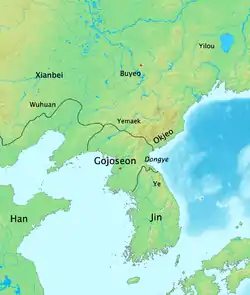 Korea 108 BC
Korea 108 BC The Four Commanderies of Han, 107 BC
The Four Commanderies of Han, 107 BC Korea in 1 AD
Korea in 1 AD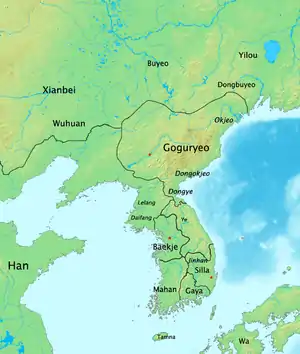 Korea 204 AD
Korea 204 AD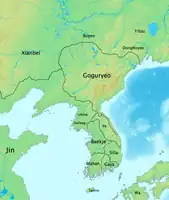 Korea in 300 AD
Korea in 300 AD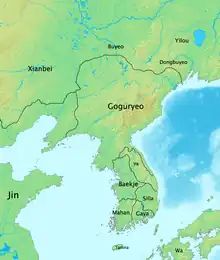 Korea in 315 AD
Korea in 315 AD Korea in 375 AD
Korea in 375 AD Korea in 410 AD
Korea in 410 AD Korea in 476 AD
Korea in 476 AD Korea in 576 AD
Korea in 576 AD Goguryeo–Sui War in 598 AD
Goguryeo–Sui War in 598 AD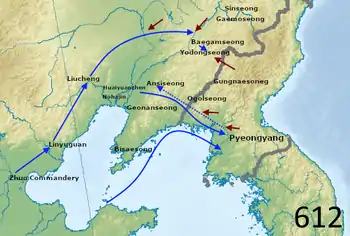 Goguryeo–Sui War in 612 AD
Goguryeo–Sui War in 612 AD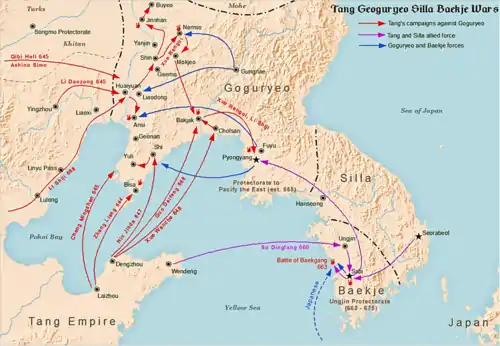 Goguryeo–Tang War (645–668)
Goguryeo–Tang War (645–668) Silla–Tang War (672–676)
Silla–Tang War (672–676) Little Goguryeo (699–820)
Little Goguryeo (699–820)_(4261052261).jpg.webp) Unified Silla and Balhae in the 8th century AD
Unified Silla and Balhae in the 8th century AD Balhae in 800 AD
Balhae in 800 AD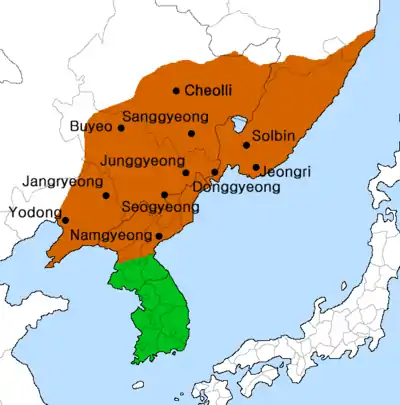 Balhae in 830 AD
Balhae in 830 AD
 Korea in 915 AD
Korea in 915 AD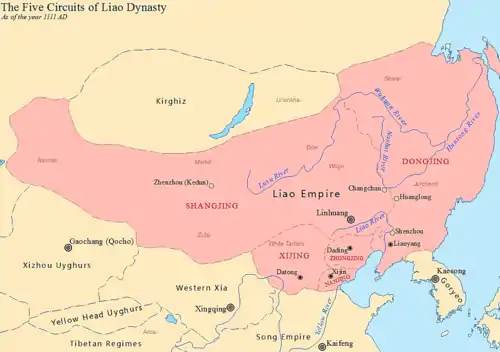 Liao dynasty (907–1125)
Liao dynasty (907–1125)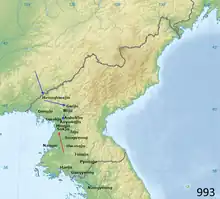
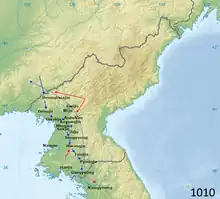 Second conflict in the Goryeo–Khitan War (1010 AD)
Second conflict in the Goryeo–Khitan War (1010 AD) Third conflict in the Goryeo–Khitan War (1018 AD)
Third conflict in the Goryeo–Khitan War (1018 AD)
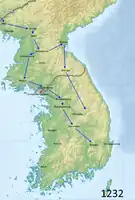 1232 Mongol invasion of Goryeo
1232 Mongol invasion of Goryeo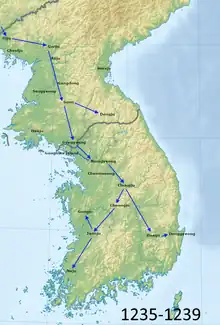 1235 Mongol invasion of Goryeo
1235 Mongol invasion of Goryeo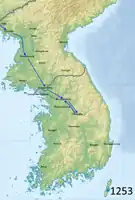 1253 Mongol invasion of Goryeo
1253 Mongol invasion of Goryeo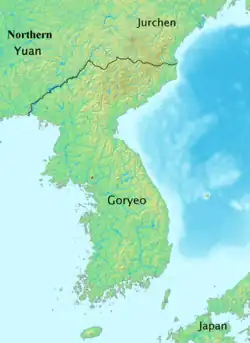 Goryeo in 1374
Goryeo in 1374_(4261814162).jpg.webp) Joseon (15th century)
Joseon (15th century)
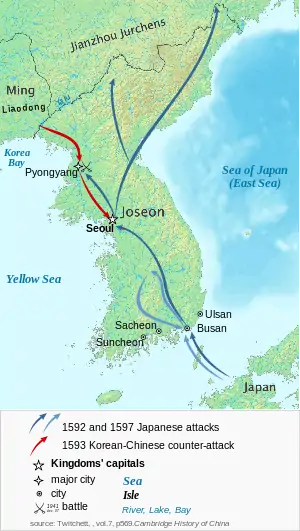
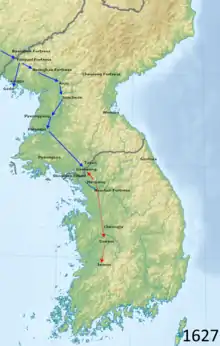 Later Jin invasion of Joseon in 1627
Later Jin invasion of Joseon in 1627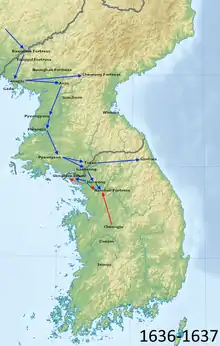 Qing invasion of Joseon (1636–1637)
Qing invasion of Joseon (1636–1637) First Sino-Japanese War (25 July 1894 – 17 April 1895)
First Sino-Japanese War (25 July 1894 – 17 April 1895).svg.png.webp) Empire of Japan (1868–1947)
Empire of Japan (1868–1947)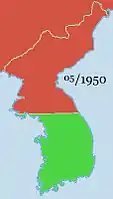 Korean War May 1950
Korean War May 1950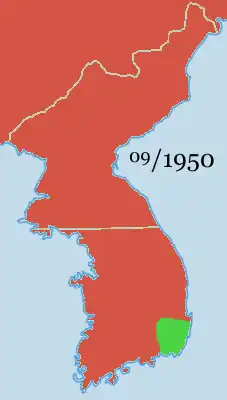 Korean War September 1950
Korean War September 1950 Korean War November 1950
Korean War November 1950 Korean War January 1951
Korean War January 1951 Korean War July 1953
Korean War July 1953
See also
- Korean monarchs' family trees: Silla; Goryeo; Joseon
- List of Korean monarchs
- History of Korea
- Military history of Korea
- Timeline of Seoul history
References
- ↑
- Seth, Michael J. (2010b). A History of Korea: From Antiquity to the Present. Rowman & Littlefield Publishers. p. 443. ISBN 978-0-7425-6717-7.
- "An extreme manifestation of nationalism and the family cult was the revival of interest in Tangun, the mythical founder of the first Korean state... Most textbooks and professional historians, however, treat him as a myth."
- Stark, Miriam T. (2008). Archaeology of Asia. John Wiley & Sons. p. 49. ISBN 978-1-4051-5303-4.
- "Although Kija may have truly existed as a historical figure, Tangun is more problematical."
- Schmid, Andre (2013). Korea Between Empires. Columbia University Press. p. 270. ISBN 978-0-231-50630-4.
- "Most [Korean historians] treat the [Tangun] myth as a later creation."
- Peterson, Mark (2009). Brief History of Korea. Infobase Publishing. p. 5. ISBN 978-1-4381-2738-5.
- "The Tangun myth became more popular with groups that wanted Korea to be independent; the Kija myth was more useful to those who wanted to show that Korea had a strong affinity to China."
- Hulbert, H. B. (2014). The History of Korea. Routledge. p. 73. ISBN 978-1-317-84941-4.
- "If a choice is to be made between them, one is faced with the fact that the Tangun, with his supernatural origin, is more clearly a mythological figure than Kija."
- ↑ Ahn, Jae-ho (2000). "Hanguk Nonggyeongsahoe-eui Seongnib (The Formation of Agricultural Society in Korea)". Hanguk Kogo-Hakbo (in Korean). 43: 41–66.
- ↑ Bale, Martin T. (2001). "Archaeology of Early Agriculture in Korea: An Update on Recent Developments". Bulletin of the Indo-Pacific Prehistory Association. 21 (5): 77–84.
- ↑ Crawford, Gary W.; Gyoung-Ah Lee (2003). "Agricultural Origins in the Korean Peninsula". Antiquity. 77 (295): 87–95. doi:10.1017/S0003598X00061378. S2CID 163060564.
- ↑ Kang, In Uk (2020). "Archaeological Perspectives on the Early Relations of the Korean Peninsula with the Eurasian Steppe" (PDF). Sino-Platonic Papers: 3.
- ↑ Lee, Seong Jai (February 2016). A Study on the Background of the Outbreak of the Warfare between Gojoseon and Yan. Conference: Interdisciplinary Research Theory and Technology 2016. p. Abstract. Retrieved 19 July 2023.
- ↑ Yi, Kisung (Spring 2015). "Transition from the Prehistoric Age to the Historic Age: The Early Iron Age on the Korean Peninsula". Asian Perspectives. 54 (1): 185–186. Retrieved 17 May 2023.
- ↑ Lew, Young Ick (2000). BRIEF HISTORY OF KOREA —A Bird's-EyeView— (PDF). New York: The Korea Society. p. 33. Retrieved 7 June 2023.
- ↑ "Korea, 1000 B.C.–1 A.D." MET Museum. Retrieved 22 May 2023.
- ↑ "Early Korea". Archived from the original on 25 June 2015. Retrieved 15 June 2015.
- ↑ Lew, Young Ick (2000). BRIEF HISTORY OF KOREA —A Bird's-EyeView— (PDF). New York: The Korea Society. p. 7. Retrieved 7 June 2023.
- ↑ Lew, Young Ick (2000). BRIEF HISTORY OF KOREA —A Bird's-EyeView— (PDF). New York: The Korea Society. p. 7. Retrieved 7 June 2023.
- ↑ Lew, Young Ick (2000). BRIEF HISTORY OF KOREA —A Bird's-EyeView— (PDF). New York: The Korea Society. p. 7. Retrieved 7 June 2023.
- ↑ Zatko, Martin (2011). The Rough Guide to Seoul. Penguin Random House. p. 170.
- ↑ Kim, Taesik (August 2005). "The Cultural Characteristics of Korea's Ancient Kaya Kingdom" (PDF). International Journal of Korean History. 8: 188. Retrieved 7 June 2023.
- ↑ Matray, James (2016). Crisis in a Divided Korea: A Chronology and Reference Guide: A Chronology. ABC-CLIO. p. 7-8. ISBN 9781610699938.
- ↑ Matray, James (2016). Crisis in a Divided Korea: A Chronology and Reference Guide: A Chronology. ABC-CLIO. p. 8. ISBN 9781610699938.
- ↑ Byington, Mark E. "Control or Conquer? Koguryǒ's Relations with States and Peoples in Manchuria," Journal of Northeast Asian History volume 4, number 1 (June 2007):93.
- ↑ Historical Atlas of the Classical World, 500 BC--AD 600. Barnes & Noble Books. 2000. p. 2.25. ISBN 978-0-7607-1973-2.
- ↑ "King Gogukwon". KBS World. Retrieved 12 June 2023.
- ↑ Lew, Young Ick (2000). BRIEF HISTORY OF KOREA —A Bird's-EyeView— (PDF). New York: The Korea Society. p. 7. Retrieved 7 June 2023.
- ↑ Lew, Young Ick (2000). BRIEF HISTORY OF KOREA —A Bird's-EyeView— (PDF). New York: The Korea Society. p. 7. Retrieved 7 June 2023.
- ↑ Best, Jonathan (2002). "Buddhism and Polity in Early Sixth-Century Paekche". Korean Studies. 26 (2): 167. JSTOR 23719761. Retrieved 14 July 2023.
- ↑ Hall, John Whitney (1988). The Cambridge History of Japan. Cambridge University Press. p. 362. ISBN 9780521223522. Retrieved 29 July 2016.
- ↑ Lee, Jong-Rok (2017). "An Analysis on the Contents of the Stele of Koguryŏ in Ji'an with Regard to Koguryŏ's Reorganization of Sumyoje". International Journal of Korean History. 22 (2). Retrieved 9 August 2023.
- ↑ Jung, Woon Yong (2005). "Trends in Koguryŏ's Relationship with Paekche and Silla during the 4th-7th Centuries". International Journal of Korean History. 8 (1). Retrieved 9 August 2023.
- ↑ Yim, SEUNG-HYE. "Korea's lesser-known Baekje era finally comes into focus". Korea JoongAng Daily. Retrieved 14 August 2023.
- ↑ La Universidad de Seúl, 《Seoul Journal of Korean Studies,》, Vol.17, 2004. p.16
- ↑ Samguk Sagi, Book4
- ↑ "Buddhism: A New Tradition". The Metropolitan Museum of Art. Retrieved 30 August 2023.
- ↑ "Nara to Norwich". Sainbury Institute for the study of Japanese Arts and Cultures. Retrieved 30 August 2023.
- ↑ Yim, SEUNG-HYE. "Korea's lesser-known Baekje era finally comes into focus". Korea JoongAng Daily. Retrieved 14 August 2023.
- ↑ Kim, Deok-Won (15 March 2023). "The establishment of the Alliance in the Three Kingdoms period and its impacts". Journal of Military History (126): 14. Retrieved 30 August 2023.
- ↑ Injae, Lee; Miller, Owen; Park, Jinhoon; Yi, Hyun-Hae (2014). Korean History in Maps. Cambridge University Press. p. 44-49, 52-60.
- ↑ Yi, Ki-baek (1984). A New History of Korea. Harvard University Press. p. 47. ISBN 978-0674615762. Retrieved 16 November 2016.
- ↑ Kim, Jongseo; Jeong, Inji. "고려사 (발해인 수만 명이 내투해오다)". 고려시대. Retrieved 29 January 2023.
- ↑ Song (2016), pp. 19–20.
- 1 2 Savenije, Henny. "Hendrick Hamel". www.hendrick-hamel.henny-savenije.pe.kr. Retrieved 21 June 2023.
- 1 2 Ledyard, Gari (1971). The Dutch Come to Korea. Seoul Korea: Royal Asiatic Society. pp. Whole book.
- ↑ "『조선 신보』(朝鮮新報)". 부산역사문화대전. Retrieved 5 October 2023.
- ↑ "Hanseong sunbo (Hanseong Ten-Daily) - Heritage Search". Cultural Heritage Administration - English Site. Retrieved 26 August 2023.
- ↑ "Chungdong First Methodist Church (서울 정동교회) : VISITKOREA". Chungdong First Methodist Church (서울 정동교회). Retrieved 17 December 2023.
- 1 2 3 4 "Foreign Relations of the United States, 1947, The Far East, Volume VI - Office of the Historian". history.state.gov. Retrieved 4 July 2023.
- ↑ 오, 승훈; 김, 경애 (2 November 2021). ""한국 최초의 영화관 '애관극장' 사라지면 안되잖아요"" ["We Can't Let the First Movie Theater in Korea, 'Ae Kwan Theater' Disappear"]. www.hani.co.kr (in Korean). Retrieved 10 September 2023.
- ↑ "Hwangudan Altar (환구단) : VISITKOREA". Hwangudan Altar (환구단). Retrieved 25 August 2023.
- ↑ "김창환협률사 - 디지털광주문화대전 : 광산구". www.grandculture.net. Retrieved 24 August 2023.
- ↑ Jhoo, Dong-chan (21 April 2015). "Curtain falls on nation's first movie theater". koreatimes. Retrieved 5 September 2023.
- ↑ Hae-yeon, Kim (23 February 2023). "[Newsmaker] Handwritten English translation of Feb. 8 Declaration of Independence found after 104 years". The Korea Herald. Retrieved 28 September 2023.
- ↑ Boram, Kim (14 October 2019). "Theater Dansungsa reborn as film museum". Yonhap News Agency. Retrieved 5 September 2023.
- ↑ Lee, Jae-lim (20 February 2020). "Century of Korean film: 100 years after first local movie, industry makes history on global stage". koreajoongangdaily.joins.com. Retrieved 8 October 2023.
- ↑ Lee, Gyu-lee (13 October 2019). "Centennial of Korean cinema - From humble beginnings to mega hits". koreatimes. Retrieved 8 October 2023.
- 1 2 3 Lankov, Andrei (5 December 2010). "Communist Kim Il-sung's Manchurian struggle in 1930-40s". The Korea Times. Retrieved 8 July 2023.
- ↑ Shin, Seung-geun (24 December 2022), 일제·소련 박해에도 '한글 100년'…고려일보를 아시나요 [Despite Japanese and Soviet suppression, '100 years of Hangul'... Do you know of the Koryo Ilbo] (in Korean), The Hankyoreh, retrieved 6 April 2023
- ↑ Kenji, Hasegawa (16 September 2020). "The Massacre of Koreans in Yokohama in the Aftermath of the Great Kanto Earthquake of 1923". Monumenta Nipponica. 75 (1): 91–122. doi:10.1353/mni.2020.0002. ISSN 1880-1390. S2CID 241681897.
- ↑ "亀戸事件" [Kameido Incident]. Kokushi Daijiten (in Japanese). Tokyo: Shogakukan. 2012. OCLC 683276033. Archived from the original on 25 August 2007. Retrieved 11 August 2012.
- ↑ "Murder of an Anarchist Recalled: Suppression of News in the Wake of the 1923 Tokyo Earthquake". The Asia-Pacific Journal: Japan Focus. The Asahi Shinbun Cultural Research Center. 3 November 2007. Retrieved 8 July 2023.
- ↑ Kenji, Hasegawa (16 September 2020). "The Massacre of Koreans in Yokohama in the Aftermath of the Great Kanto Earthquake of 1923". Monumenta Nipponica. 75 (1): 91–122. doi:10.1353/mni.2020.0002. ISSN 1880-1390. S2CID 241681897.
- ↑ Lee, Jinhee (1 January 2008). "The Enemy Within: Earthquake, Rumors, and Massacre in the Japanese Empire". Violence: Mercurial Gestalt: 187–211.
- ↑ "Five of Jap Leaders Recent Shanghai Row Wounded by Bombers—Madera Tribune". cdnc.ucr.edu. California Digital Newspaper Collection. 29 April 1932. Retrieved 16 August 2023.
- ↑ "In memory of Yun Bong-gil and His Bombing in Shanghai". Ministry of Patriots and Veterans Affairs. 29 April 2008. Retrieved 15 August 2023.
- 1 2 3 4 "Korea - Cairo Declaration, Yalta Conference, and Potsdam Conference | Britannica". www.britannica.com. Retrieved 4 July 2023.
- ↑ "Secret American Pact With Stalin Exposed in Yalta Papers". The Canberra Times. Vol. 29. 18 March 1955. p. 1. Retrieved 10 July 2023.
- ↑ Elsey, G. M. "Memorandum by the Assistant to the President's Naval Aide". Office of the Historian. Retrieved 10 July 2023.
- ↑ "독수리작전 (Eagle Project)" [Eagle Project], Encyclopedia of Korean Culture (in Korean), retrieved 29 March 2023
- ↑ Son, Sae-il (6 February 2008), "孫世一의 비교 傳記 (71)" [Son Sae-il's Comparative Critical Biography (71)], Monthly Chosun Ilbo (in Korean), retrieved 1 May 2023
- ↑ Seth (2010), pp. 88–89.
- ↑ "백의사(白衣社)". encykorea.aks.ac.kr (in Korean). Retrieved 14 January 2024.
- ↑ Seth (2010), pp. 87.
- ↑ Seth (2010), pp. 88.
- ↑ Seth (2010), pp. 90–91.
- ↑ Seth (2010), pp. 91–92.
- ↑ "조선기록과학영화촬영소가 걸어온 영광의 행로 (1)" [On the Path of the Korea Documentary Science Film Studio #1], DPRK Today (in Korean), 24 November 2018, retrieved 29 May 2023
- ↑ Bae, Jin-yeong (September 2010), "김일성 반대는 예술인의 양심에서 출발한 것" ["Opposition to Kim Il Sung came from the artist's conscience"], Monthly Chosun Ilbo (in Korean)
- ↑ Seth (2010), pp. 92.
- ↑ Seth (2010), pp. 94.
- ↑ "백의사" [White Shirts Society], Encyclopedia of Korean Culture (in Korean)
- ↑ "United Nations Commission on Korea (UNCOK)". Government of Canada. 11 December 2018. Retrieved 30 June 2023.
- 1 2 3 Seth (2010), pp. 94–95.
- ↑ Sang-Hun, Choe (28 May 2019). "Memories of Massacres Were Long Suppressed Here. Tourists Now Retrace the Atrocities. (Published 2019)". The New York Times. ISSN 0362-4331. Retrieved 1 December 2020.
- 1 2 3 Seth (2010), pp. 97.
- ↑ Yang, Changyong; Yang, Sejung; O'Grady, William (October 2019). Jejueo: The Language of Korea's Jeju Island. Honolulu, Hawaii: University of Hawaiʻi Press. p. 12. ISBN 9780824874438.
- ↑ "Jeju, UNESCO Atlas of the World's Languages in Danger". unesco.org. 11 June 2017. Retrieved 16 May 2020.
- 1 2 Seth (2010), pp. 95.
- ↑ Lankov, Andrei (4 September 2008). "(502) What Happened to Kim Ku". koreatimes. Retrieved 14 January 2024.
- ↑ Shen, Zhihua (22 June 2020). "Revisiting Stalin's and Mao's Motivations in the Korean War | Wilson Center". www.wilsoncenter.org. Retrieved 11 July 2023.
- 1 2 Seth (2010), pp. 101.
- 1 2 Zhihua, Shen (2000). "Sino-Soviet Relations and the Origins of the Korean War: Stalin's Strategic Goals in the Far East". Journal of Cold War Studies. 2 (2): 44–68. ISSN 1520-3972. JSTOR 26925062.
- ↑ Seth (2010), pp. 101–102.
- ↑ Seth (2010), pp. 102.
- ↑ Seth (2010), pp. 107.
- 1 2 Seth (2010), pp. 103.
- ↑ Seth (2010), pp. 103–104.
- 1 2 3 4 5 Seth (2010), pp. 104.
- ↑ 국민방위군 사건 (in Korean). National Archives of Korea. Archived from the original on 27 April 2011. Retrieved 20 July 2010.
- ↑ Seth (2010), pp. 105–106, 110.
- ↑ Wolf, Charles (1962). "Economic Planning in Korea". Asian Survey. 2 (10): 22–28. doi:10.2307/3023492. ISSN 0004-4687. JSTOR 3023492.
- ↑ 서, 영수 (23 March 2013). "[내 인생을 바꾼 순간]28년 전 남극 첫발 디딘 한국인, 이동화 대표" [[The Moment That Changed My Life] Lee Dong-hwa, the First Korean to Set Foot in Antarctica 28 Years Ago]. 동아일보 (in Korean). Retrieved 8 July 2023.
- ↑ 전, 수진 (28 December 2009). "85년 한국 첫 남극관측탐험대 이끌었던 홍석하씨" [The Leader of the First Korean Expedition to Antarctica, Hong Seok-ha]. 중앙일보 (in Korean). Retrieved 8 July 2023.
- ↑ 배, 종호; 이, 윤성 (21 October 1994). "성수대교 붕괴사고...예견된 인재" [The Seongsu Bridge collapse disaster...a foreseeable incident] (in Korean). KBS News. Archived from the original on 17 February 2023. Retrieved 17 February 2023.
- ↑ Okada, Taihei (1 January 1999). "The "Comfort Women" Case: Judgement of April 27, 1998, Shimonoseki Branch, Yamaguchi Prefectural Court, Japan". Washington International Law Journal. 8 (1): 64.
- ↑ Wakabayashi, Bob T. (2003). "Review: Comfort Women: Beyond Litigious Feminism". Monumenta Nipponica. 58 (2): 251 – via JSTOR.
- ↑ "International Brief: Dr. Soyeon Yi | APPEL Knowledge Services". appel.nasa.gov. APPEL News Staff. Retrieved 8 July 2023.
- ↑ "N. Korean media confirm leader's uncle Jang Song Thaek ousted". UPI. Retrieved 30 June 2022.
- ↑ "North Korean Leader Kim Jong-un Executed His 'Worse Than a Dog' Uncle". ABC News. Retrieved 30 June 2022.
- ↑ "Tycoon wanted in fatal South Korean boat capsize found dead". South Korea News.Net. Archived from the original on 28 July 2014. Retrieved 23 July 2014.
- ↑ Park, Madison; Hancocks, Paula (16 April 2015). "Sewol ferry disaster: One year on, grieving families demand answers". CNN. Retrieved 15 July 2015.
- ↑ "South Korea's Moon Jae-in sworn in vowing to address North". BBC News. 10 May 2017. Retrieved 8 July 2023.
- ↑ "'We've so many questions unanswered': botched response blamed for Seoul crush". South China Morning Post. 13 January 2023. Retrieved 4 July 2023.
- ↑ "Attacked opposition leader Lee's surgery completed, progress closely monitored". Yonhap News English. 2 January 2024. Archived from the original on 3 January 2024. Retrieved 2 January 2024.
- ↑ Sang-Hun, Choe (1 January 2024). "South Korean Opposition Leader Is Stabbed". The New York Times. Archived from the original on 2 January 2024. Retrieved 1 January 2024.
Sources
- Seth, Michael J. (2010). A Concise History of Modern Korea: From the Late Nineteenth Century to the Present. Rowman & Littlefield. ISBN 9780742567139.
- Song, Inho, ed. (2016). Namdaemun Market. Translated by Atkinson, Timothy V. Seoul Museum of History. ISBN 979-1186324370.
Further reading
- Benjamin Vincent (1910), "Corea", Haydn's Dictionary of Dates (25th ed.), London: Ward, Lock & Co., hdl:2027/loc.ark:/13960/t89g6g776 – via Hathi Trust
- Ian Preston, ed. (2001). "Republic of Korea". Political Chronology of Central, South and East Asia. Political Chronologies of the World. Europa Publications. pp. 160–181. ISBN 978-1-135-35680-4. + "Democratic People's Republic of Korea"
External links
- Timeline of Korean history
- "Timeline of 20th-century Korean history". USA: Public Broadcasting Service (PBS).
- Comparative China-Korea-Japan arts timeline
- BBC News (May 2018). "South Korea Profile: Timeline". BBC News.
- BBC News (26 April 2019). "North Korea Profile: Timeline". BBC News.
- "Timeline of Korean History". Asia for Educators. USA: Columbia University.
- "Korea". Heilbrunn Timeline of Art History. New York: Metropolitan Museum of Art.
This article is issued from Wikipedia. The text is licensed under Creative Commons - Attribution - Sharealike. Additional terms may apply for the media files.